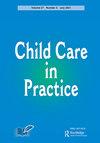编辑
IF 1.4
Q3 FAMILY STUDIES
引用次数: 0
摘要
本期《儿童保育实践》中的七篇文章在许多方面对我们提出了挑战,以重新定义我们如何理解残疾以及残疾发生在家庭和社会环境中的事实。Thomas Skaf和Jenney(2020)的文章为这一讨论提供了一个很好的起点。像“残疾”这样的词可能有一种倾向,即在没有意识到随着时间的推移可能与之相关的复杂性、变异性或负面预设的情况下,被广泛使用。这篇文章挑战我们通过理解“Ableism”(关于“正常”的话语和实践的激增)和“Disableism”(可以定义为与残疾相关的消极态度和属性)的概念来应对这一问题。引用论文中的话,“残疾主义是指由于残疾人的真实或感知障碍而抹杀他们的能力和人性,从而导致偏见、歧视和压迫”,文章接着描述了一些例子。这让我们了解到,残疾和残疾发生在多个层面上,而不仅仅是身体层面。在Flynn(2020)的文章中,作者探讨了残疾儿童有效保护和福利评估的障碍,并重点阐述了在儿童保护背景下对“Ableism”的理解。Flynn(2020)引用了IFSW在2014年对社会工作的全球定义,该定义提倡在尊重多样性(而不仅仅是文化多样性)的情况下赋予权力和解放的愿景,并承认考虑到我们所有服务的压力,找到时间进行反思性实践并不容易。然而,有必要将叙事从消极转变为积极,我们可以通过以下方式做到这一点:(i)强调儿童权利;(ii)从残疾中学习,以改善与所有儿童的实践;(iii)更多地关注解决方案和安全,而不是长时间考虑问题和因果关系。本期的一些文章强调了残疾的具体方面,以及其中许多方面是相互联系或可能相互影响的事实。Yesilkaya等人的文章(2019)是第一个很好的例子,强调了视觉障碍可能导致的残疾。这篇文章提高了人们的认识,即残疾不仅影响特定的个人,还影响他们周围更广泛的人类家庭——他们的直系亲属,以及教育工作者和其他人。正如上面的一位作者所评论的那样,“残疾是一种社会建构的体验”。考虑到上述一些压力,研究得出的证据往往很难为实践提供信息。这篇文章以范围界定综述的形式,是一个很好的例子,说明了为什么这种联系对所有从业者都至关重要,因为它的目的是“识别、整理和评估现有的研究证据,了解针对视力障碍儿童、其父母/监护人或教育工作者的干预措施的实施障碍和促进因素”,这不仅可以导致综合工作,还可以导致未来实践的积极变化(Yesilkaya et al.,2019,p.1)。Flynn(2019)的第二篇文章涉及2008年及以后爱尔兰经济衰退导致的紧缩措施对智障青年及其家庭的影响。与Yesilkaya等人(2019)一样,其目的是在未来的实践中带来积极的变化。Flynn(2019)使用了一种框架分析方法,该方法适用于通过传记叙事解释法(BNIM)制作的访谈记录本文章由计算机程序翻译,如有差异,请以英文原文为准。
Editorial
The seven articles within this issue of Child Care in Practice challenge us in a number of ways to re-define how we understand disability and the fact that disability occurs within a family and societal setting. A good starting point for this discussion is offered within the article by Thomas-Skaf & Jenney (2020). There can be a tendency for words such as “Disability” to be used in a general, catch-all sense, without realising either the complexity, variation or negative presuppositions which over time can come to be associated with it. This article challenges us to confront this through developing an understanding of the concepts of “Ableism” (the proliferation of discourses and practices about being “normal”) and “Disableism” (which can be defined as the negative attitudes and attributes associated with disability). Quoting from the paper, “Disableism involves the erasure of a disabled person’s capabilities and humanity because of their real or perceived impairments, which results in prejudice, discrimination, and oppression” and the article goes onto describe a number of examples. It leads to the insight that Disability and Disablement occur on a number of levels – not just the physical. In the article by Flynn (2020), the author looks at barriers to effective child protection and welfare assessment with disabled children, and also focusses on understandings of “Ableism” within the child protection context. Flynn (2020) cites the global definition of social work provided by the IFSW in 2014 which promotes a vision of empowerment and liberation with respect for diversities (and not just cultural ones) and acknowledges that given the pressures upon all our services, finding time for reflective practice is not easy. However, there is a need to change the narrative from the negative to the positive, which we can do through (i) an emphasis on children’s rights (ii) learning from disability to improve practice with all children and (iii) a focus more towards solutions and safety, rather than prolonged consideration of problems and causation. A number of the articles in this issue highlight specific aspects of disability and also the fact that many of these are linked or can occur as a consequence of each other. The article by Yesilkaya et al. (2019) is a first good example, highlighting disability which can occur as a result of visual impairment. The article raises awareness that disability not only affects a specific individual, but the wider human family around them – their immediate family, as well as educators and others. As one of the authors above comments “disability is a socially constructed experience”. Given some of the pressures cited above, the link between research leading to evidence which can inform practice often seems hard to make. This article, in the form of a scoping review, is an excellent example of why this link is critical to all practitioners, as it aims to “identify, collate and appraises the available research evidence on implementation barriers and facilitators of interventions for children with visual impairments, their parents/ guardians or educators” which can then lead not only to integrated working but also lead to positive changes in future practice (Yesilkaya et al., 2019, p.1). The second article by Flynn (2019) relates to the impact of austerity measures, arising from the Irish economic recession in 2008 and beyond, on intellectually disabled young people and their families. The intention, as with Yesilkaya et al. (2019), is to lead to positive changes in future practice. Flynn (2019) uses a Framework Method of analysis applied to transcripts produced from a Biographical Narrative Interpretative Method (BNIM) of interviewing, across a
求助全文
通过发布文献求助,成功后即可免费获取论文全文。
去求助
来源期刊

Child Care in Practice
Nursing-Community and Home Care
CiteScore
3.30
自引率
5.30%
发文量
32
期刊介绍:
Child Care in Practice is a quarterly, peer-reviewed journal that provides an international forum for professionals working in all disciplines in the provision of children’s services, including social work, social care, health care, medicine, psychology, education, the police and probationary services, and solicitors and barristers working in the family law and youth justice sectors. The strategic aims and objectives of the journal are: • To develop the knowledge base of practitioners, managers and other professionals responsible for the delivery of professional child care services. The journal seeks to contribute to the achievement of quality services and the promotion of the highest standards. • To achieve an equity of input from all disciplines working with children. The multi-disciplinary nature of the journal reflects that the key to many successful outcomes in the child care field lies in the close co-operation between different disciplines. • To raise awareness of often-neglected issues such as marginalization of ethnic minorities and problems consequent upon poverty and disability. • To keep abreast of and continue to influence local and international child care practice in response to emerging policy. • To include the views of those who are in receipt of multi-disciplinary child care services. • To welcome submissions on promising practice developments and the findings from new research to highlight the breadth of the work of the journal’s work.
 求助内容:
求助内容: 应助结果提醒方式:
应助结果提醒方式:


